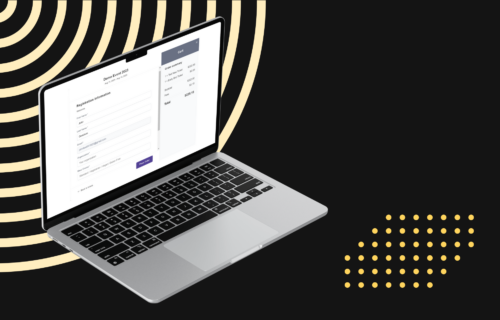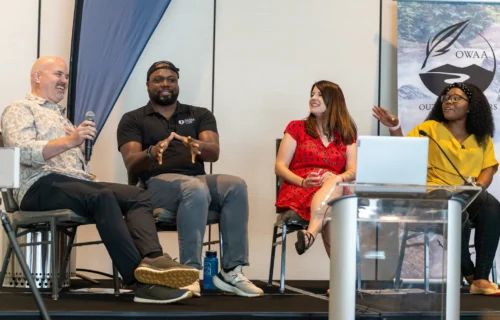Planning a meaningful event in the upcoming months? The speakers you choose can make or break it.
If you’re aiming to spark new ideas and leave a lasting impression, it all starts with the right voices on your agenda. But keep in mind that launching a successful call for speakers is a strategy that shapes the tone, quality, and success of your entire event.
In this guide, you’ll learn how to launch a call for speakers in 2025, including what information to collect, how to build a timeline, where to promote it, and how to make the process easier for all parties involved.
Main Takeaways
Table of contents
- Launch your call for speakers 5-7 months before your event, with a clear application window, review process, and timeline for speaker prep.
- A good call for speakers form captures more than just a bio. Collect speaker background, session details, audio visual needs, and links to past presentations.
- Speaker promotion is just as important as the form. Mix direct outreach to your dream speakers with wider promotional tactics like email, social posts, and community groups.
- Be clear about what you’re looking for. Define your theme, audience, and goals upfront to attract the right speakers (and make your review process faster).
- Make the process easy for everyone involved. Use a speaker management tool like Sched’s Call for Papers to collect, sort, and review submissions all in one hub.
When To Launch a Call for Speakers: A Month-by-Month Breakdown
An established timeline will help you make sure your speaker lineup and associated materials are ready in time for your event. Keep in mind that your speaker lineup will also impact logistics, such as travel and accommodation preparations.
Most event planners start the planning process 5 to 7 months before the event, depending on the event size. Below is a general month-by-month breakdown.
Month 1: Prepare and Promote
- Set your application window (typically open for 4-6 weeks).
- Define selection criteria and eligibility.
- Publish your call on your website or speaker portal.
- Start promoting the opportunity to your network and industry groups.
- Create templates for confirmation, rejection, and follow-up emails.
Month 2: Review and Notify
- Review submissions (expect this to take between 2 to 6 weeks).
- Select your top candidates based on your defined criteria.
- Notify accepted speakers promptly (and reach out to backups if needed).
- Give accepted speakers a 1-2 week window to confirm their participation.
Month 3: Build Your Schedule
- Finalize your session lineup.
- Start drafting the event schedule.
- Identify gaps and follow up on outstanding speaker information.
Month 4: Finalize Session Materials
- Collect headshots, bios, presentation titles, and session descriptions.
- Ask for any audio visual or tech needs.
- Set deadlines for slide decks or handouts.
Month 5: Do a Dry Run
- Schedule speaker prep calls or rehearsals.
- Walk through session logistics.
- Share the final schedule with all speakers as soon as it’s finalized.
What to Include in Your Call for Speakers Application
Before launching a call for speakers, make sure the event’s content objectives are clearly defined.
Include practical information about the session or conference and its theme, as well as the type of presentations you’re looking for. Providing this helpful information helps applicants determine whether their topic is suitable for the event, which saves you time during the review phase.
These are some suggestions for what to include in your Call for Speakers application:
1. General Information
Overview of the event
- Event dates
- Event theme
- Location
Important information about the call
- Deadlines
- Where to send the application
- The selection process and timeframe
- Eligibility criteria
- Any terms & conditions
2. Speaker Information
Key Details
- Name of presenter
- Company
- Job title
- Email address
- Phone number
- Social media handles
- Names of any additional presenters
- Professional references
- An outline of their presenting experience
- Video links to previous talks
- Speaker bio
- Are they speaking as an individual or on behalf of an organization?
Event session information
- Session title
- Session description
- What will attendees take away from this session?
- How does the session connect to the event?
- What type of audience does the session target?
- What experience level is the session suitable for? (e.g. beginner, intermediate, advanced)
- What materials will the speaker share with participants?
- Ideal session length
- What technological equipment and/or set-up does the session require?
- What will the session format be?
- Has the content been presented elsewhere?
- Has the speaker published anything on the topic? (e.g. books, articles, podcasts, papers)
→ Tip: Use an online form builder or speaker management tool so presenters can upload materials directly and avoid back-and-forth emails.
How to Promote Your Call for Speakers in 2025
You won’t get any great submissions if no one hears about your call. Use a mix of targeted outreach and broader promotion so your pool of applicants is greater:
🎯 Direct Outreach
1. Reach out to past speakers from previous events. Drop them an email to see if they’re interested in submitting a new idea. If possible, use the same template you used when you invited them previously.
2. Send a personalized invite to well-known experts in your space. Use social media to find respectable voices in your industry (Twitter and LinkedIn usually work best here). Make sure your message clearly demonstrates the value of presenting at your event.
3. Contact speakers who have given related talks at other events. Identify a list of past conferences that are relevant to your event theme and audience. Look for speakers who have given talks similar to yours before. If possible, review the post-event content to check the quality of the presenter’s session and materials.
→ Tip: Always make it very clear why they’re a great fit for your event and what’s in it for them (e.g. visibility, networking, comped registration).
📣 Indirect Promotion
1. Share the call on social media, especially LinkedIn and industry groups. Create a series of posts that highlight what makes your event unique and include a clear deadline to drive urgency.
2. Send a dedicated email blast to your contact list. Make the subject line compelling, and clearly explain what you’re looking for, who should apply, and how they’ll benefit from speaking at your event.
3. Post in newsletters, online communities, and listservs. These spaces often have highly engaged members looking for speaking opportunities. Tailor your message to match the interests of each group.
4. Write a blog post that helps potential speakers submit a strong proposal. Include tips for applying, spotlight what makes your event special, and link directly to the application form. It also helps more people find your event online.
→ Tip: If you happen to run a K-12 school or education-focused event, consider reaching out to administrators, PD leaders, or teacher influencers who might spread the voice with their networks.
Plan Your Next Call For Speakers with Shed’s Call for Papers Free Tool
Launching a successful call for speakers involves having a process that makes things easier for you and your applicants. That’s why thousands of organizers rely on Sched to manage their speaker lineup, call for papers, and session scheduling in a central hub. Plus, the tool is completely free!
Sched’s Call for Papers feature lets you:
- Create a professional and distinctive call-for-speakers page in just three simple steps. It’s a huge time saver.
- Add multiple speakers to a single session and manage their profiles dynamically.
- Save lots of time as it reviews the applications, presenting you with a refined list of top candidates.
Get your next event rolling with less back-and-forth. Set up your call for speakers on Sched for free.
FAQs
What is a call for speakers?
A call for speakers, or call for papers, is a public invitation for experts to apply to speak at your event. It helps organizers find qualified presenters and build a relevant, engaging agenda.
How far in advance should I launch a call for speakers?
Ideally, you should launch your call for speakers 5-7 months before your event, depending on the event size. This gives you enough time to collect submissions, make smart selections, gather materials, and promote the schedule.
What should I include in my call for speakers application?
Your call for speakers application form should include details about the event, submission guidelines, speaker information (name, bio, contact, past experience), and proposed session details (title, topic, audience, format).
Where should I promote my call for speakers?
To promote your call for speakers, start with direct outreach to people you know. Then promote on LinkedIn, email newsletters, your website, relevant Slack groups, and industry listservs.
How can I make my speaker process more efficient?
One way to make your speaker process more efficient is to use speaker management tools like Sched’s Call for Papers tool to collect, sort, and manage submissions. It makes it easy for speakers to submit their proposals, and lets you customize the platform to fit your event’s specific requirements.








